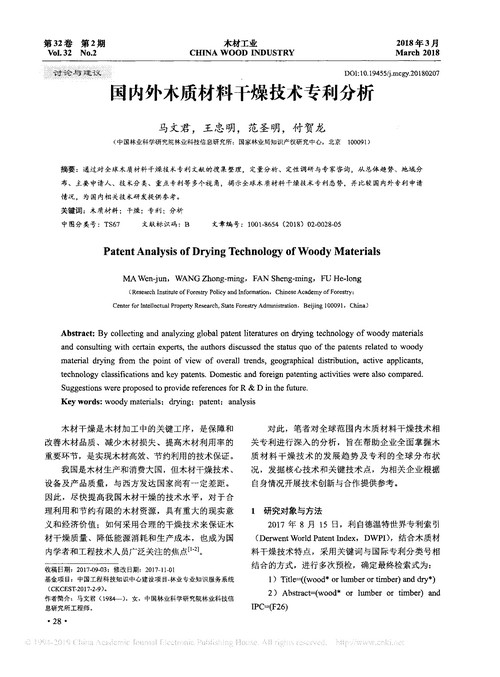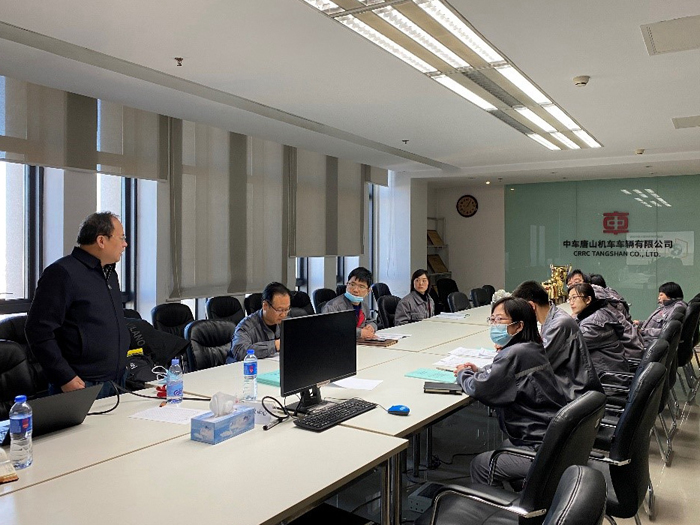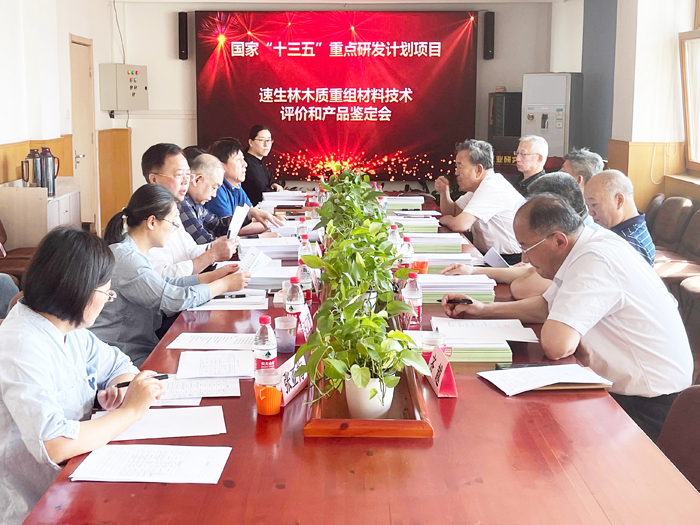
木质材料缺陷无损检测主要研究进展
编号
lyqk002578


中文标题
木质材料缺陷无损检测主要研究进展


期刊名称
世界林业研究


年份
2008


卷号
21


期号
5


栏目编号
1


栏目名称
专题论述


中文摘要
从基于成像技术、信号传播速度变化、人工模拟缺陷和信号处理的木质材料缺陷无损检测以及木质材料缺陷对其力学性能的影响5个方面论述了木质材料缺陷无损检测的研究进展,简要分析了目前研究中存在的主要问题及其发展趋势。


基金项目
国家自然基金(30700629);优秀博士论文专项资助项目(200764)


英文标题
Development Tendency and Research Progress of Non-destructive Testing for Wooden Material's Defects


作者英文名
Miao Yuanyuan,Liu Yixing,Liu Zhenbo and Zhang Xianquan


英文摘要
Non-destructive testing for defects is an important technology for utilizing of wooden material effectively and reasonably. Facing the shortage of wooden material in the world nowadays, the effective non-destructive testing for wooden material's defects appears importance. The main course of researches on non-destructive testing for wooden material's defects is reviewed, including the imaging technique, the changing of signal propagation velocity, defects of manual simulation, signal processing of non-destructive testing for wooden material's defects and influence of wooden material's defects upon mechanical property. Then the existing problems of non-destructive testing for wooden material's defects are analyzed in brief,and development tendency is forecasted.


英文关键词
wooden material;defects;non-destructive testing


起始页码
44


截止页码
50


投稿时间
2008/6/2


分类号
S781.5


参考文献
[1] Dunlop J .I Testing of poles by using acoustic pulse method[J].Wood Sci Technol, 1981, 15: 301-310.
[2] Dunlop J .I Testing of poles by acoustic resonance[J]. Wood Sci Techno,l 1983, 17: 31- 38.
[3] L Machek, M L Edlund, R Sierra-Alvarez, et al. Anon-destructive approach for assessing decay in preservative treated wood[J]. Wood Sci Technol, 2004, 37: 411-417.
[4] Madsen B. Structural behaviour of tmiber[R]. North Vancouver, Canada: Timber Engineering Ltd, 1992: 239- 241.
[5] Hatayama Y. A new estmiation of structural lumber considering the slope of the grain around knots[J]. Bull For For Prod ResInst 1984, 326: 69-167.
[6] NakaiT, Ebihara T, Tanaka T. Grade and bending strength of Douglas fir square sawn tmiber (in Japanese)[C]//Abstracts of 34th Annual Meeting of Japan Wood Research Society, Nagoya, 1984: 285.
[7] Iijima Y, NakaiT. Species effect on MOE-MOR relation of square sawn lumber [C]//Proceedings of 1990 International Tmiber Engineering Conference, Tokyo, 1990: 842-846.
[8] TakashiTakeda, Takeo Hashizume. Differences of tensile strength distributions between mechanically high-grade and low-grade Japanese larch lumber III effect of knot restriction on the strength of lumber[J]. J Wood Sci 2000, 46: 95- 101.
[9] F Lam, J D Barret,t S Nakajima. Influence of knot area ratio based grading rules on the engin eering properties of Hem-fir used in Japanese post and beam housing[J]. Wood SciTechnol,2004, 38: 83-92.
[10] Yoshitaka Kubojmia, Mario Tonosak,iHiroshi Yoshihara. Young smodulus obtained by flexural vibration test of a wooden beam withinhom ogeneity of density[J]. JWood Sci 2006, 52: 20 -24.
[11] Hu Y C, Nakao T, Nakai T, et al Dynamic properties of three types of wood-based composites[J]. J Wood Sci, 2005, 51: 7-12.
[12] Hu Y C, Nakao T, Nakai T, et al Vibration prop erties of wood plastic plywood[J]. JWood Sci 2005, 51: 13- 17.
[13] Kubojima Y, OhtaM , OkanoT. Vib rational properties of heat treated green wood[J]. J Wood Sc,i 2000, 46: 63-68.
[14] Guan H Y. Dynamic properties of wood in the moisture content region above the fiber saturation poin t[D]. Tottori, Japan: United G raduate School of Agriculture, Tottori University, 2002.
[15] Dong Y K. Dynamic properties for in-planeinhomogeneous wood-based materials [D]. Tottor,iJapan: United Graduate School of Agriculture, Tottori Universit 1996.
[16] Naki T, HamatakeM, Nakao T. Relationship between piezoelectric behavior and the stress-strain curve of wood under com bined compression and vibration stresses[J]. J Wood Sci 2004,50: 97-99.
[17] Obataya E, Minato K, Tomita B. Influence of moisture contenton the vibrational properties of hematoxyl in-impregnated wood[J]. J Wood Sci, 2001, 47: 317-321.
[18] Xu H, Tanaka C, Nakao T, et al. Evaluation of rolling shear strength of ply wood by flexural vibration method [J]. J Wood Sci, 1998, 44: 147-151.
[19] Yang X Y, Amano T, Ishmiaru Y, et al. Application of modal analysis by the transfer function on nond estructive test of wood II. Elasticity evaluation of different quality part with in wooden beam by the curvature on flexural vibration wave[J]. M okuzai Gakkaishi 2001, 47: 412- 419.
[20] Yang X Y, Ishmiaru Y, Iida I. Application of modal analysis by the transfer function to nondestru ctive testing of wood II:Idetection of knots and estmiation of elastic modulus distribution in wood by the curvature ratio of the flexural vibration wave shape[J]. Mokuzai Gakkaish,i 2002, 48: 16- 22.
[21] 许文台. x射线检测木材实验报告 [J]. 森林工业通讯, 1979(2): 6.
[22] 青郁, 刘自强, 崔广兴, 等. 木材内腐 x光电视检测研究 [J].东北林业大学学报, 1983(4): 109-114.
[23] 刘自强, 戴澄月, 韩奎焕. 木材缺陷的射线无损检测 [J]. 林业科学, 1984(2): 220-223.
[24] 刘自强, 乔景禄, 戚大伟. 木材缺陷图像的伪色彩处理 [J].林业科学, 1989(2): 185-189.
[25] 邓志刚, 邓荣斌. 板材缺陷的微波检测 [J]. 林业机械与木工设备, 1998(6): 30-31.
[26] Tayloy F W, Wagner F G Jr, McMillin C W, et al. Locating knots by Industrial tomography-A feasibility study[J]. Forest ProdJ, 1984, 34: 42-46.
[27] Funt B V, Bryant E C. Detection of internal log defects by auto matic interpretation of computer miages [J]. Forest Prod ,J1987, 37: 56- 62.
[28] Grundberg S. Scanning for Interna l Defects in Logs[D]. Lu lea,Sweden: Lulea University of Technology, 1994: 14.
[29] Gerson Rojas, Alfon so Condal, Robert Beauregard, et al. Hern and ez. Identification of internal defect of sugar map le logs from CT images using supervised class if ication method s[J]. Holzals Roh-und Werkstoff 2006, 64: 295- 303.
[30] 吕立仁, 陈兆斌. 超声波检测木材质量的可行性探讨 [J]. 铁道技术监督, 1999(6): 33- 34.
[31] 杨学春. 基于应力波原木内部腐朽检测理论及试验的研究[D]. 哈尔滨: 东北林业大学, 2004.
[32] 林文树. 应力波与超声波在木材内部缺陷检测中的对比研究[D]. 哈尔滨: 东北林业大学, 2005.
[33] 林文树, 杨慧敏, 王立海. 超声波与应力波在木材内部缺陷检测中的对比研究 [J]. 林业科技, 2005, 30(2): 39- 41.
[34] 段新芳, 王平, 周冠武, 等. 应力波技术在古建筑木构件腐朽探测中的应用 [J]. 木材工业, 2007, 21(2): 10- 13.
[35] 崔英颖. 基于振动法进行木材应力分等和缺陷检测的研究[D]. 北京: 北京林业大学, 2006.
[36] 杨慧敏, 王立海. 基于超声波频谱分析技术的木材孔洞缺陷无损检测 [J]. 东北林业大学学报, 2007, 35(8): 30- 32.
[37] Raczkow skiJ, Lutom skiK, MoliskiW, et al. Detection of early stages of wood decay by acoustic emission technique[J]. Wood Science and Technology, 1999, 33: 353-358.
[38] M E Tiitta, F C Bell J M Biern acki. Class ification study for using acoustic- ultrasonics to detect internal decay in glulam beams[J]. Wood Science and Technology, 2001, 35: 85-96.
[39] D Ouis, A Zerizer Modeling rot in wood by replacem ent of wood with sand: an expermi ental study[J]. JWood Sci 2006,52: 1-5.
[40] Fook Choon Choi, Jianchun Li Bijan Samali, et al A pplication of modal- based damage-detection method to locate and evaluate damage in tmiber beams[J]. J Wood Sci, 2007, 53: 394 -400.
[41] Chuanshuang H u, Muh amm ad T A fza.l A statistical algorithm for comparing mode shapes of vibration testing before and after damage in timbers[J]. J Wood Sci 2006, 52: 348-352.
[42] Chuan shuang H u, M uh amm ad T A fzal. A wavelet analysis -based approach for damage localization in wood beams [J]. J Wood Sci, 2006, 52: 456- 460.
[43] 徐凯宏. 压阻式木材内部缺陷类无损检测理论与技术的研究 [D]. 哈尔滨: 东北林业大学, 2004.
[44] Xiaoyang Yang, Yu taka Ishmiaru, Ikuho Iida, et al. Application of modal analysis by transfer function to nondestru ctive testing of wood :Ideterm ination of localized defects in wood by the shape of the flexural vibration wave[J]. J Wood Sci 2002, 48: 283-288.
[45] Xiaoyang Yang, Takuro Amano, Yutaka Ishmiaru, et al Application of modal analysis by transfer function to nondestructive testing of wood II modulus of elasticity evaluation of sections of differing quality in a wood en beam by the curvature of the flexural vibration wave[J]. J Wood Sci 2003, 49: 140- 144.
[46] 孙建平, 王逢瑚, 于海鹏. 小波分析与人工神经网络在木质材料无损检测中的应用 [J]. 木材工业, 2004, 18(5): 24-26.
[47] 王逢瑚, 孙建平. 木质复合材料无损检测中振动信号的处理方法 [J]. 东北林业大学学报, 2004, 32(1): 61- 63.
[48] 牟洪波. 基于人工神经网络的木材缺陷检测研究 [D]. 哈尔滨: 东北林业大学, 2006.
[49] 朱红娟. 基于小波神经网络木质材料无损检测方法研究[D]. 北京: 北京林业大学, 2007.


PDF全文
浏览全文


-
相关记录
更多
- 基于黏结剂喷射的木质材料增材制造技术研究进展 2023
- 木质材料在黄河“非遗”数字化展示空间设计中的应用 2022
- 声发射技术在木质材料损伤监测中的应用研究进展 2022
- 作品名称:宅以木作——基于木质材料的空间营造设计 2022
- 基于人工智能的苗木质量无损检测研究进展 2020
- 应力波木材无损检测技术应用及研究进展 2020
 打印
打印


